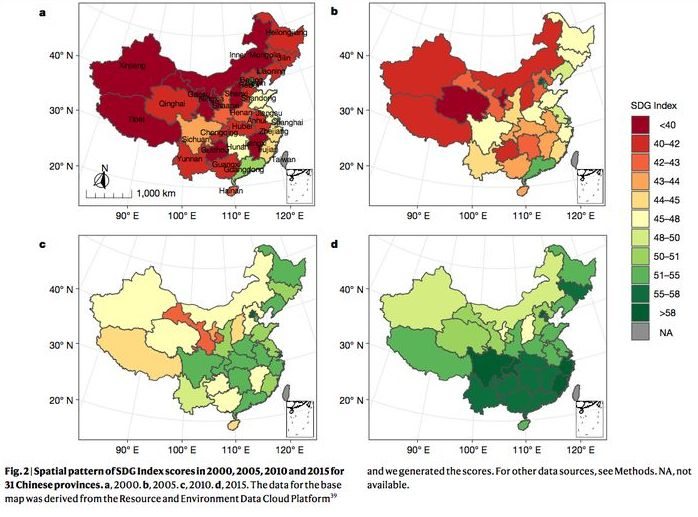Jan 2 2020
Countries across the globe have been adhering to a blueprint from the United Nations to develop a more sustainable future. However, a new study reveals that the blueprint cannot be a permanent solution, and would have to be remodeled constantly.
 Spatial pattern of SDG Index scores in 2000, 2005, 2010, and 2015 for 31 Chinese provinces. Between 2000 and 2015, China has improved its aggregated SDG score. At the provincial level, however, there is a disparity between the country’s developed and developing regions. Image Credit: Michigan State University.
Spatial pattern of SDG Index scores in 2000, 2005, 2010, and 2015 for 31 Chinese provinces. Between 2000 and 2015, China has improved its aggregated SDG score. At the provincial level, however, there is a disparity between the country’s developed and developing regions. Image Credit: Michigan State University.
Researchers working on sustainability have created comprehensive and systematic evaluation methods and carried out a first evaluation of the progress of a country’s in achieving all 17 UN Sustainable Development Goals (SDGs) not merely as a nation, but even at the regional levels, and not merely as a snapshot, but over time.
In “Assessing progress towards sustainable development over space and time” published in the Nature journal this week, researchers from Michigan State University (MSU) and in China describe that like politics, all sustainability is, in fact, local.
Although a nation can claim an overall movement toward a sustainable future, regions within the nation indicate the losses and gains in the struggle with inequality, poverty, environmental degradation, and climate for peace and justice, as well as prosperity. The study found that the most striking aspect is the inequalities between the developed and developing regions.
“We have learned that sustainability’s progress is dynamic, and that sometimes gains in one important area can come at costs to another area, tradeoffs that can be difficult to understand but can ultimately hobble progress,” stated Jianguo “Jack” Liu, MSU Rachel Carson Chair in Sustainability and senior author.
Whether it’s protecting precious natural resources, making positive economic change or reducing inequality—it isn’t a static score. We must carefully take a holistic view to be sure progress in one area isn’t compromised by setbacks in other areas.
Jianguo “Jack” Liu, MSU Rachel Carson Chair in Sustainability, Michigan State University
The researchers evaluated China by using techniques that can be applied to other countries as well. The enormous size and broad socioeconomic changes of China at the national and provincial levels demonstrated the shift of progress in sustainability. From 2000 to 2015, China has improved its aggregated SDG score as a nation.
However, at the provincial level, there is inequality between the developed and developing regions of the country. In the 2000s, when compared to the more rural west China, East China—home to the country’s economic boom—had a higher SDG Index score. In comparison with the agricultural-intensive and industrialized north China, south China had a higher SDG Index score in 2015.
According to Zhenci Xu, a recent PhD graduate from MSU’s Center for Systems Integration and Sustainability (MSU-CSIS) who headed the research work, nations are tasked with the immediate goal of achieving sustainability even with increase in populations, land degradation, scarce natural resources such as water and energy, uneven economic development, and intensified gender and income inequalities.
Throughout the entire study period of 2000 to 2015, developed provinces were found to have higher (and thus better) SDG Index scores compared to developing provinces. However, in developing provinces, the average SDG Index scores were increasing more rapidly than in developed provinces.
“China’s eastern region began developing during the reform and opening-up policy in the late 70s to spur economic development along the coasts, which was accompanied by better social services,” stated Xu.
In 1999, China started to address the rural western parts which had lagged in progress. That saw improvements both in infrastructure and ecological conservation, which seems to have boosted their sustainable development. The eastern parts have begun to struggle with the consequences of rapid economic growth—such as pollution and inequities.
Zhenci Xu, PhD Graduate, Center for Systems Integration and Sustainability, Michigan State University
According to the authors, there has been progress in overall sustainability mainly due to better healthcare, education, and environmental conservation policies. The research indicates that despite advances, it is vital to investigate what is happening at regional levels to learn where resources and attention must be directed.
Apart from Liu and Xu, the study was authored by Sophia Chau, Yingjie Li, Thomas Dietz, Julie Winkler, Shuxin Li, Anna Herzberger, and Ying Tang from MSU and Jian Zhang, Jinyan Wang, Xiuzhi Chen, Fan Fan, Baorong Huang, Shaohua Wu, Dequ Hong, and Yunkai Li from Chinese universities and academies. At present, Xu is a research intern at the University of Michigan’s School for Environment and Sustainability.
The study was financially supported by the National Science Foundation, MSU, Michigan AgBioResearch, and China Scholarship Council.